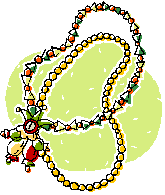



|
Seed Beads Explained By Tracy Stillman It’s hard to believe that for centuries, the production of seed beads has been shrouded in secrecy. Bragging about the techniques would have cost a Venetian bead maker his life a few hundred years ago and, even today, the Japanese closely guard some of the processes involved in seed bead production. The term ‘seed beads’, refers to the tiny beads used in bead jewelry and textiles, which are also affixed to accessories like handbags, shoes, lamp-shades and other decorative items. They are finicky to work with and can send you scuttling off to the optometrist, but they produce some of the most exquisite, intricate beadwork. For many years, the Europeans held the biggest claim to seed bead production. Italy, Czechoslovakia (now the Czech Republic) and to a lesser degree, France, were the front-runners in producing these very popular beads. Europe still produces seed beads today, as do many other countries such as China, India, Pakistan, Turkey and Iran. It is Japan though, that has the enviable reputation of producing the finest quality seed beads in the world. Seed beads come in just about every shape and color imaginable and may be transparent, foil lined or opaque. Although they are sometimes made from plastic or metal, they are typically made of glass. Understandably, every country involved in making seed beads has their own technique but certain elements of the production processes are similar. For instance, the first step in the process is liquefying silica sand. Whilst the French heat the silica sand to temperatures over 1200ºC, over a number of weeks, the Japanese heat it over a day. It is at this point, in both instances, that the desired color is added. Once that is done, a portion of the molten mix is released from the cauldron, and an air bubble is blown into the molten glass either by mouth or with a shot of compressed air. Either way, this step forms a space inside the molten mix and the mix forms a long, hollow tube of glass, known as a cane. While still hot, the cane is stretched. Bearing in mind that the now soft glass continues to harden as it cools, means that the speed at which the cane is stretched dictates the length of the cane, which in turn determines the size of the seed beads. Depending on the country where the beads are being made, this can be achieved with manpower or machinery. It might sound unbelievable, but in some instances, men using a metal grip, take one end of the cane each and can run up to a few hundred meters to obtain this result! Once cooled, the canes are cut into ‘beads’, although at this stage, the beads look nothing like the end product; they are dull with rough edges. The beads are then put into a mixture such as clay and charcoal and carefully tumbled, to smooth and shape them and then reheated to temperatures between 500ºC-800ºC, depending on where they are made and what type of seed bead the manufacturer is producing. This process burns the abrasive mixture and adds a yet unseen shine to the beads. They are then washed and dried and finally reveal their true color and luster. Individual taste affects opinion of what the most striking seed beads are today. Many would say the Japanese but some prefer the Czech seed beads which are not quite so perfect and often more rounded in shape. The Japanese seed beads are made by three major companies; Miyuki, Matsuno and Toho. The term ‘Japanese Delicas’, used to refer to the most highly prized seed beads, actually refers to the beads by that name made by Miyuki. When Miyuki introduced these beads, they became an overnight success and the other two Japanese players soon followed with their own versions; Matsuno’s ‘Magnifica’ and Toho’s ‘Aiko’. Consequently, when sourcing Japanese ‘Delicas’, it pays to know exactly which bead company’s version you are after. As you might imagine, given their size, there is a special system of scale used to classify seed beads. The measurement is called an aught (pronounced like taught without the ‘t’), and it is thought that this measure may have originated as the number of beads that could comfortably be strung on a one inch length of cord. The trick with seed bead sizing is to remember; the smaller the number, the larger the bead size. The most commonly used sizes are 8/0 and 11/0, although the smaller size 15/0 seed beads are often used in intricate bead weaving designs. Some of the names given to seed beads include:
Given the dazzling array of colors, shapes and sizes of the various kinds of seed beads, it’s easy to see how versatile they can be when used in different ways. They certainly require more time and effort to work with than other beads but the results they give, make the effort truly rewarding!
About the
Author:
|
|
|---|
Search the Web: 
Custom Search
|
Contact Us |
|---|